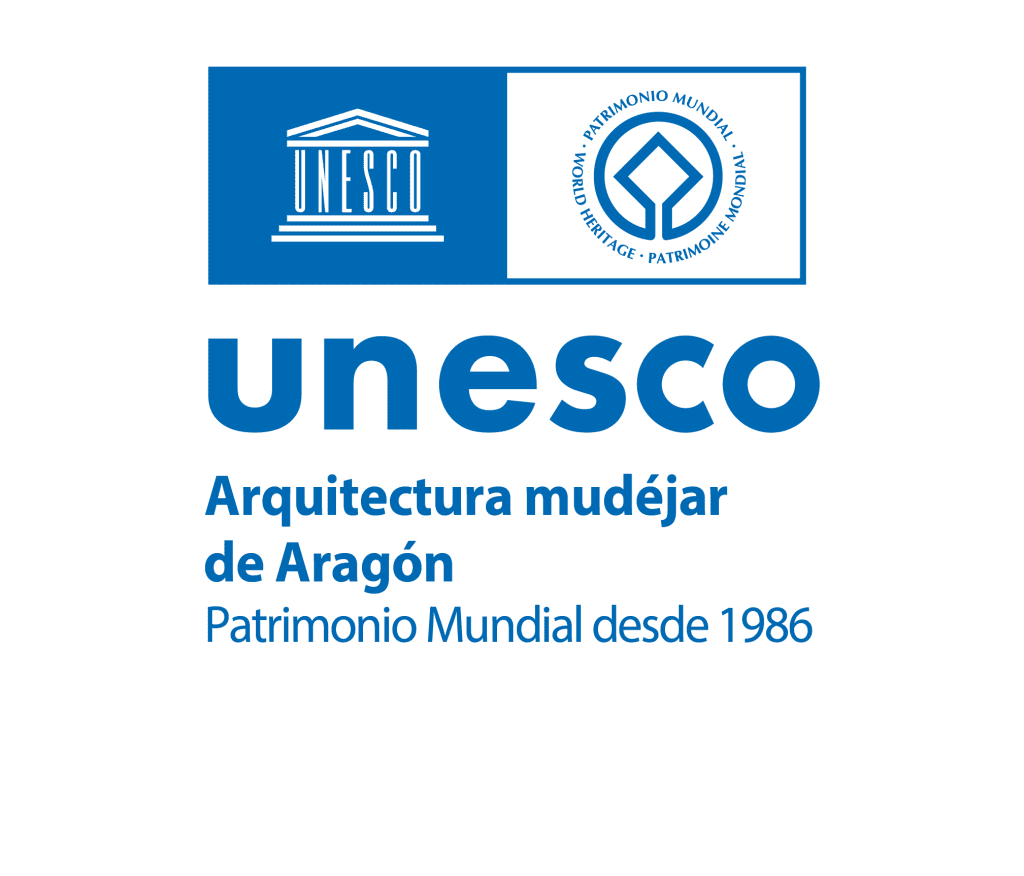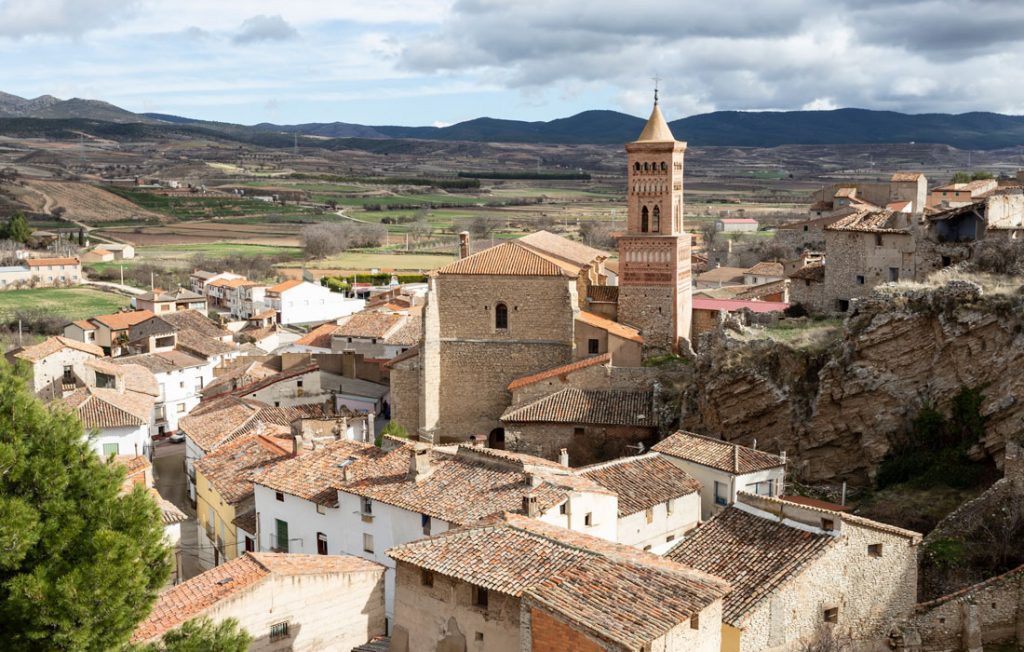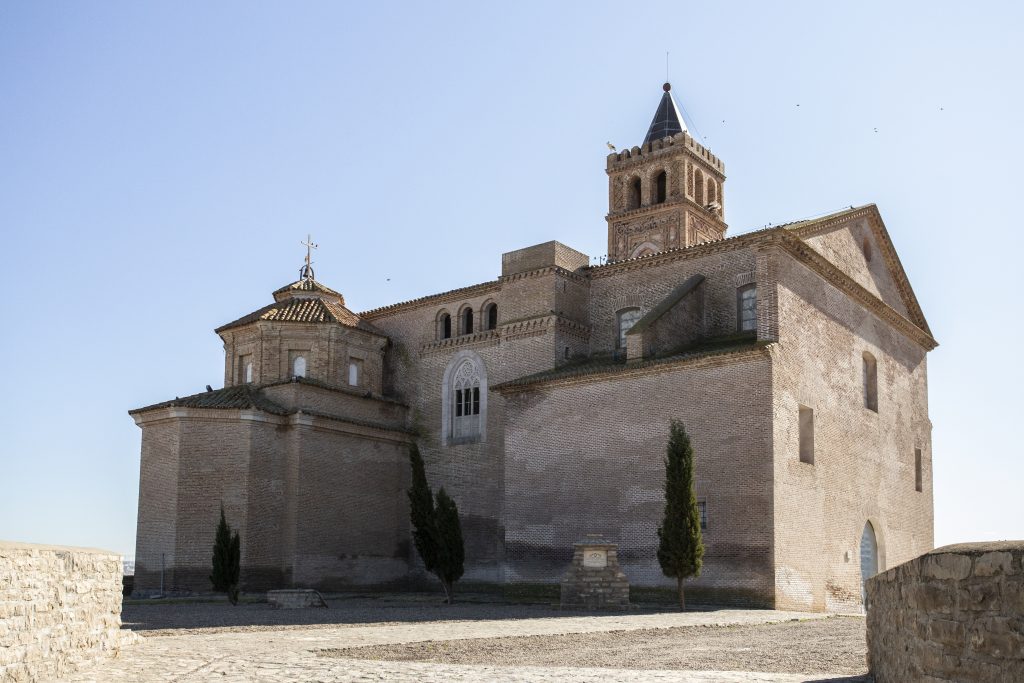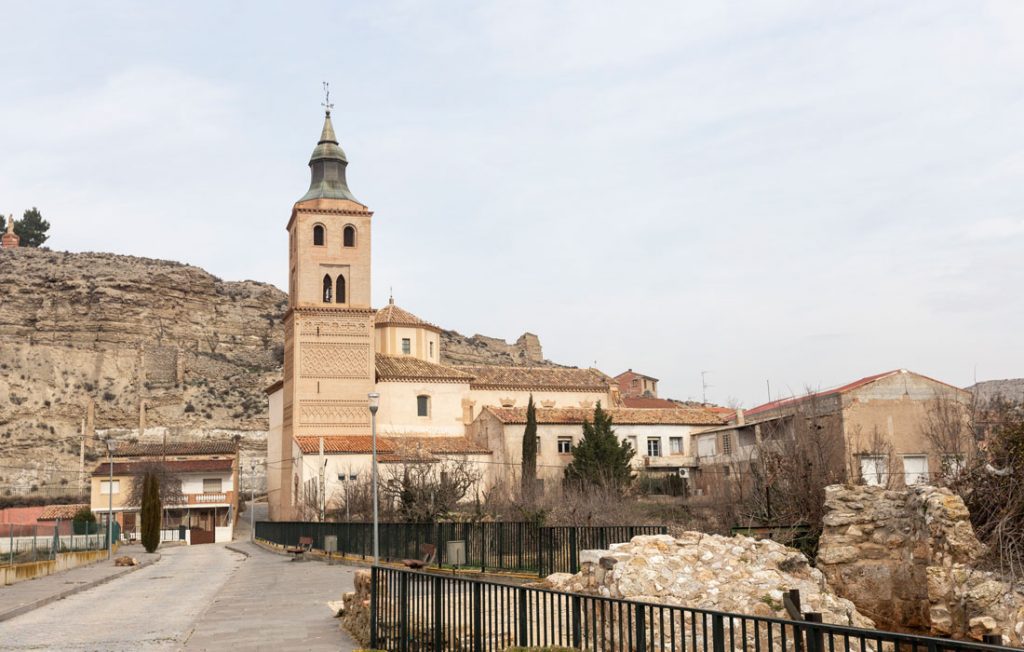
Study of Aragonese Mudejar Art
The legacy of Professor Gonzalo M. Borrás Gualis Mudejar territory
The project
In the Estudio del Arte Mudéjar Aragonés we find, in a way, the starting point of what we are as a network in Territorio Mudéjar and the work that we developed with Professor Gonzalo M. Borrás Gualis in 2010, a space for common work and understanding of the Mudejar that, from a scientific point of view, could reach anyone with a professional, intellectual or even recreational interest.
A place of work from which to promote learning at all levels with a view to recognising the profound Mudejar identity of our territory for the conscious conservation of the heritage of our villages as a fundamental part of their uniqueness and their future.
The proposal, conceived and planned as a project since 2016, was designed as an open and collaborative work process that would provide continuity to a process of updating all the work in general and specifically on Mudejar heritage developed by Professor Borrás from the sixties of the twentieth century until the beginning of the project.
What you read here represents the work done so far, we hope you find it interesting and that you can be part of the project in one way or another.
Victoria E. Trasobares Ruiz. Director and coordinator of the Estudio del Arte Mudéjar, the layman of Professor Gonzalo M. Borrás Gualis.



The team
Following Professor Borrás, the project has inherited a clearly interdisciplinary vocation from the work on the local territory (especially rural), understood from a global perspective, not only for its external and focused valuation, but also for the strengthening and reinforcement of local identities and the inhabitants who maintain the territory.
Therefore, this project involves the effort to build a growing, interdisciplinary and international working team. A high-level European team that can lay the foundations for future European and international cooperation.
In this initial phase, the project, under the direction and coordination of Victoria E. Trasobares Ruiz, has relied on the work of a team that brings together three major European university centres such as the University of Zaragoza and the Italian Polytechnic Institutes of Turin, in the area of conservation and restoration, and Milan, in the area of architecture, projects and representation.
We would like to thank the emeritus professors Esteban Sarasa Sánchez and Mª Isabel Álvaro Zamora, the professor of art history Ascensión Hernández Martínez and the tenured professors Juan Carlos Lozano, Mª Pilar Biel Ibáñez and Pedro Luis Hernando Sebastián, all from the University of Zaragoza, for their work. And at the European level, the enthusiasm for the project of the heritage specialists from Italian centres coordinated by the researcher and technical architect Irene Ruiz Bazán: the architects Chiara Ocelli, Riccardo Palma and Gianluca Vita, the first two from the Politecnico di Torino and the second from the Politecnico di Milano. In addition, we cannot forget the hard work of art historian Derry Holgado Bernabeu, as project assistant, and María Foradada Pina, as a trainee student during part of this first phase.
In this way, Territorio Mudéjar is making steady progress and consolidating its position as a management entity and a space for rural innovation from the perspective of World Heritage management, establishing strategies to have an impact on the extensive Mudejar heritage of our territory.


The method
The work takes as its starting point the beginning of an editorial work developed in 2008 together with the company Prames Editorial, in which Professor Borrás had begun to revise the 1985 reference work, providing an updated vision of Mudejar monumental heritage, from a reflective viewpoint and based on exhaustive fieldwork, taking into account the whole process of evolution and improvement that Mudéjar monuments had undergone since 1986, when Mudéjar architecture in Teruel was included in the Unesco list and, subsequently, in 2001, this was extended to the whole of Aragonese Mudéjar through the declaration of six buildings in the towns of Zaragoza, Calatayud, Cervera de la Cañada and Tobed.
In the planning of Professor Borrás, the project addressed the monographic study of each of the Aragonese Mudejar monuments, including the ten buildings declared World Heritage by Unesco, a number of monuments until reaching the failed list of 157 proposed in the year 2000, as well as some more elements following the criterion that “the lists have the permanent condition of being expandable and revisable”.
Each building should be treated in an appropriate manner to avoid making mistakes, and each monument should be treated in a manner appropriate to its artistic interest, so that the reader can clearly perceive the importance of each one.
To this end, a detailed documentary review is being carried out, starting with Professor Borrás’ own doctoral thesis from 1971, unpublished and an essential study document not only for its textual content but also for the sources, the original photographs and the planimetric graphics produced by himself, which will give us a complete view of all the material available in 2021. A review of the bibliography, files and compilation of existing planimetric and photographic archives and meticulous fieldwork will allow us in various phases of work to confirm data and incorporate new materials such as aerial photography, 3D images based on point clouds and virtual views from photogrammetry and digital reconstruction.
A work totally focused on building bridges to the future of management with a highly innovative approach and connected to new ways of connecting with people: research, conservation, education and entertainment.
The starting point, some topics to begin with...

The legacy of Professor Gonzalo M. Borrás Gualis. The working model of Territorio Mudéjar
Victora E. Trasobares Ruiz.
Director of Territorio Mudéjar.
“The project that hosts this special work is establishing itself as a possible model of action. A project created from the rural reality that understands the management of Mudejar historical-artistic resources as a real and transversal tool for development in the local territories of Aragon, incorporating all the actors involved in its management and creating models of economic development, social and territorial sustainability endowed with identity in the rural area without copying or transferring models from other places”….
Mudejars and Mudejarism in Aragon: cohabitation, coexistence, benefits and resiliencies
Esteban Sarasa Sánchez.
Professor Emeritus, University of Zaragoza.
“Mudejar as a member of a confessional collective and Mudejar art as a reminder of its extinct presence in the future would therefore be the effect and result, first in advance and then retrospectively, of resilience or, as Pedro Luis Hernando writes, of survival, far beyond the disappearance of the population that for nine hundred years formed part of the history of Spain, from 711 to 1610 with the expulsion of the converted Mudejars or Moriscos.” …
The importance of ceramics in Aragonese Mudéjar architecture
María Isabel Álvaro Zamora.
Emeritus Professor at the University of Zaragoza.
“In Islamic art, architecture in itself is not art, for what gives it artistic value is the ornamentation that covers it. This is the materialisation of its aesthetic conception, closely linked to its religious thought, whereby the decorative motifs are projected in a flat and superficial manner, in compositional rhythms of repetition and alternation, in superimposed planes or as hanging tapestries, achieving through the contrast of the different materials, their colours, brightness and changing reflections the dematerialisation of the built reality”….
The Restoration of Aragonese Mudejar Architecture
Ascensión Hernández Martínez.
Professor of Art History. University of Zaragoza.
“The declaration of Aragonese Mudejar art as a World Heritage Site two decades ago, in 2001, boosted its recovery and conservation, as well as its social dissemination. In this period there have been numerous interventions undertaken under the impulse of public administrations (especially regional and provincial), but the restoration of Mudejar architecture, which of course involves intervention in the interior of historic buildings where extraordinary pictorial decorations and impressive ceilings are preserved, is actually a long process still not sufficiently known, since it has only been studied occasionally in some large buildings”….
The intervention and restoration record: a tool for current knowledge of Mudejar architectural heritage
Irene Ruiz Bazán, Chiara Lucia Maria Occelli and Riccardo Palma. Polytechnic of Turin.
Gianluca Emilio Ennio Vita. Politecnico di Milano
“After more than fifty years of centralisation of powers in the field of monumental restoration between the Directorate General of Fine Arts and the Directorate General of Architecture, the current Spanish Historical Heritage Law of 1985 transferred powers in the field of heritage conservation to the Autonomous Communities. This transfer meant an enormous atomisation of the bodies in charge of its management, from Town Councils, Dioceses, through the Provincial Councils to the Government of Aragon or the Ministry of Culture when the projects have been carried out using the different cultural percentages earmarked for heritage conservation (1%, 1.5%) which the Historical Heritage Law itself establishes as an obligation in public works contracts and which have been numerous during the period under study, especially following the incorporation of Spain into the European Economic Community, later European Union, in 1986….
Mudejar art and heritage in the 21st century
Teachers
Mª Pilar Biel Ibáñez, Ascensión Hernández Martínez and Juan Carlos Lozano López.
University of Zaragoza
“In recent years, in addition to this research activity, another activity has been added : the enhancement and dissemination of the Mudejar as a cultural and heritage phenomenon, attached to the territory and linked to the development of the localities where it developed, and in this task the association Territorio Mudéjar maintains a close collaboration with the University of Zaragoza, through the Department of History of Art and its Master’s Degree in Cultural Heritage Management, through internships, the completion of master’s theses and a scholarship programme…”.
The buildings
- All
- Aniñón
- Ateca
- Belmonte de Gracián
- Borja
- Calatayud
- Cervera de la Cañada
- Daroca
- Fuentes de Ebro
- Illueca
- La Almunia de Doña Godina
- Longares
- Magallón
- Mainar
- Maluenda
- Mesones de Isuela
- Morata de Jiloca
- Quinto
- Ricla
- Romanos
- San Mateo de Gállego
- Saviñán
- Tauste
- Terrer
- Teruel
- Tobed
- Torralba de Ribota
- Torrellas
- Villafeliche
- Villar de los Navarros
- Villarreal de Huerva
- Zuera


Apse of the Church of San Juan de la Cuesta, Daroca

Cabañas chapel, La Almunia de Doña Godina

Casa de La Estanca, Borja

Castillo de los Luna, Mesones de Isuela

Church of San Antonio Abad, Tauste

Church of San Félix, Torralba de Ribota

Church of San Lorenzo Mártir, Magallón

Church of San Mateo Apóstol, San Mateo de Gállego

Church of San Miguel Arcángel, Villarreal de Huerva

Church of San Miguel, Belmonte de Gracián

Church of San Miguel, Borja

Church of San Miguel, Maluenda

Church of San Pedro Apóstol, Saviñán

Church of San Pedro, Zuera

Church of Santa Ana, Mainar

Church of Santa María, Tauste

Church of Santa María, Tobed

Church of Santas Justa y Rufina, Maluenda

Church of Santo Domingo de Silos, Daroca

Clock tower, Ateca

Collegiate church of the Santo Sepulcro, Calatayud

El Piquete / Museo de las Momias, Quinto

El Salvador tower, Teruel

Ex-collegiate church of Santa María, Borja

Fortified church of San Pedro Apóstol, Romanos

Gunpowder factory, Villafeliche
Home

Iglesia de San Pedro, Villar de los Navarros

Palace of the Condes de Argilllo, Saviñán

Palace of the Luna family, Daroca

Papa Luna Palace, Illueca

Parish church of Nuestra Señora de la Asunción, Longares

Parish church of Nuestra Señora del Castillo, Aniñón

San Andrés church and tower, Calatayud

San Martín de Tours, Morata de Jiloca

San Pedro de los Francos, Calatayud

Santa María de Calatayud collegiate church, Calatayud

Santa María de Mediavilla Cathedral, Teruel

Santa Tecla, Cervera de la Cañada

The church of San Pedro, Teruel

Tower and apse of the church of La Asunción de Nuestra Señora, Terrer

Tower and church of Nuestra Señora de la Asunción, Ricla

Tower of the church of La Asunción, La Almunia de Doña Godina

Tower of the church of San Martín de Tours, Torrellas

Tower of the church of San Miguel Arcángel, Villafeliche

Tower of the church of San Pedro Apóstol, Romanos

Tower of the church of Santa María, Ateca
